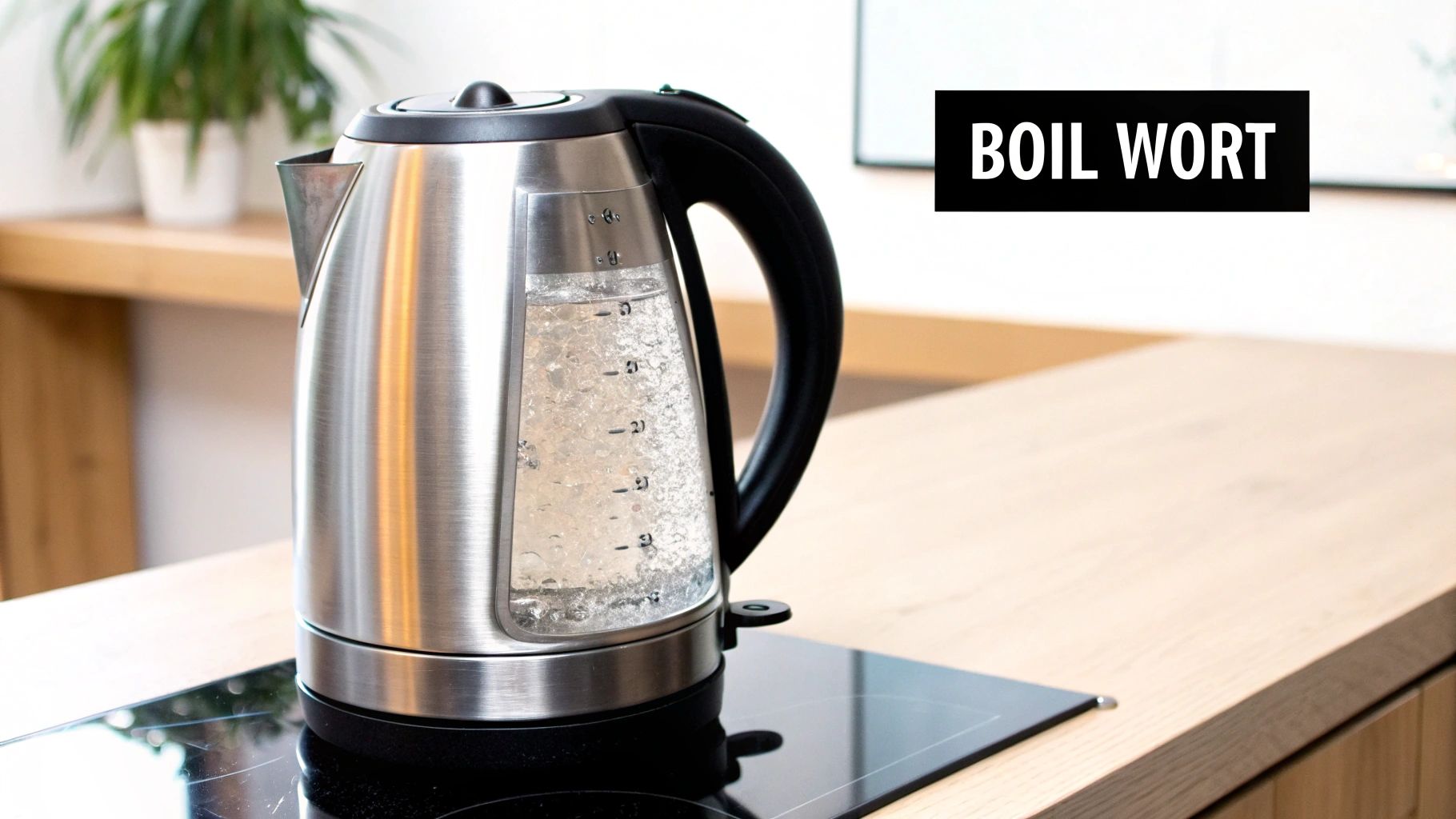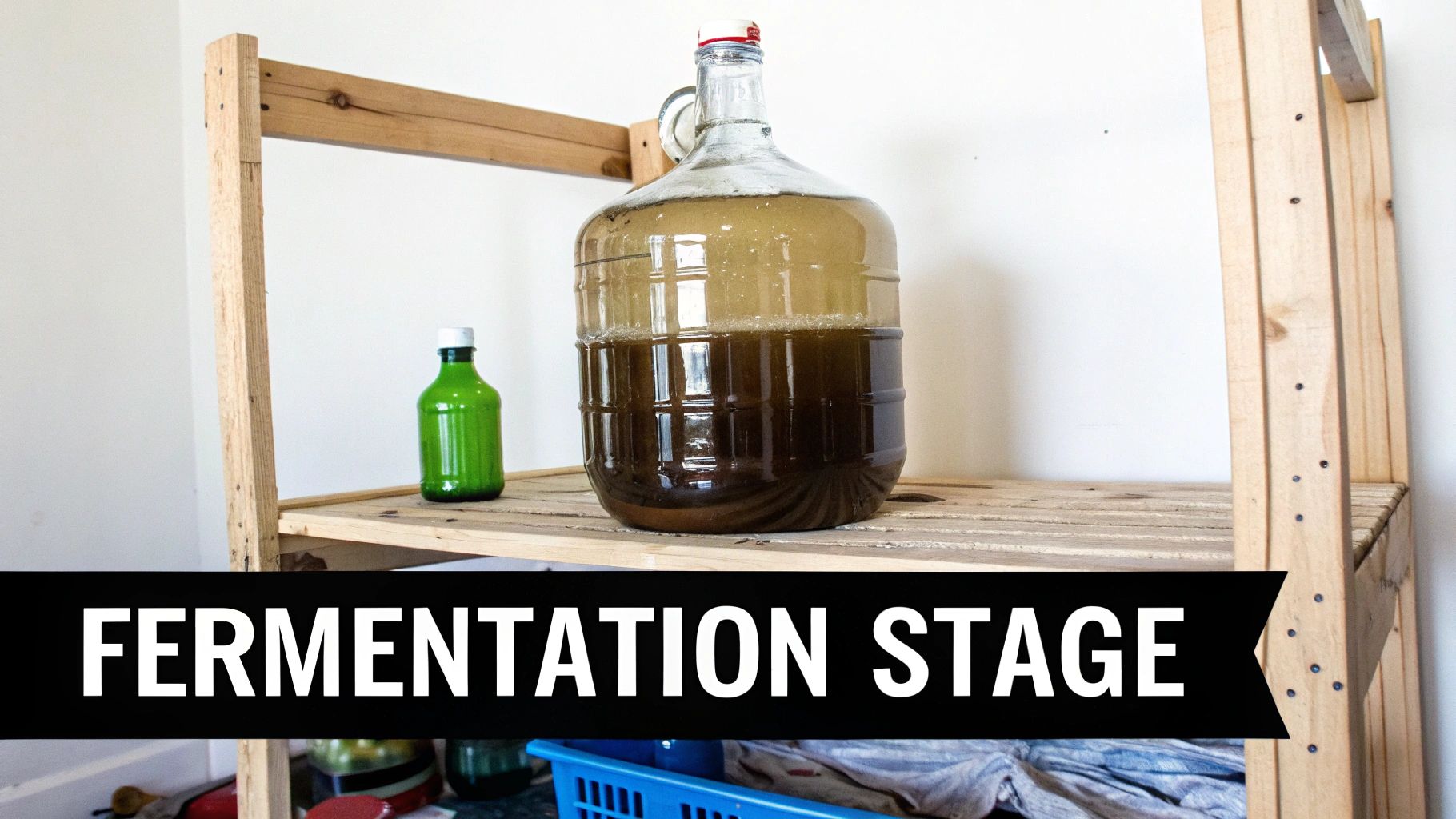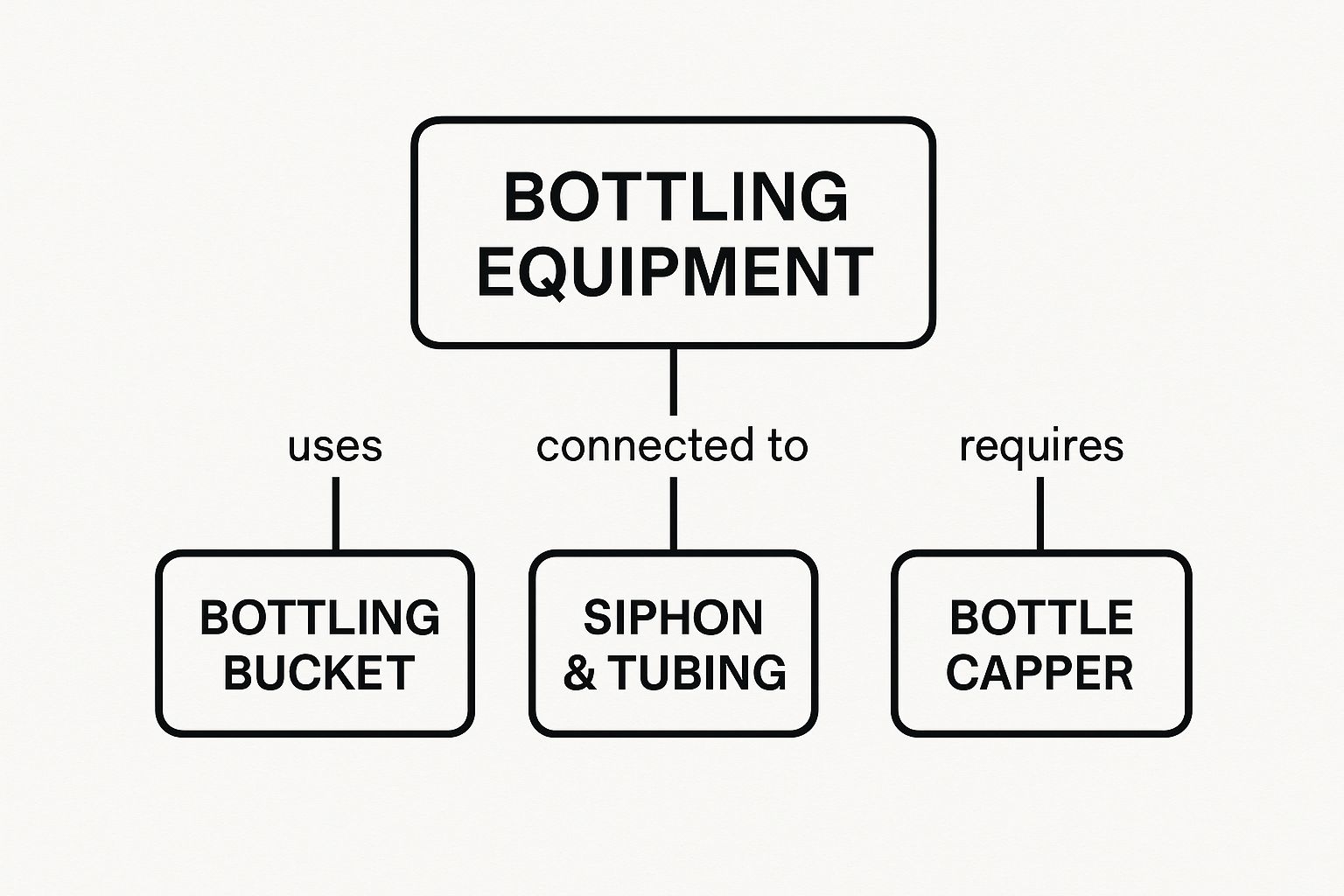
Equipment for Home Brewing Craft Coffee at Home
Share
Ready to start brewing your own speciality coffee? It's a brilliant hobby, but before you get lost in a sea of beans and techniques, let's talk about the gear. Getting the essentials sorted from the very beginning is the single best thing you can do to make sure your first brew is a success.
Think of it like this: you don't need a professional kitchen to cook a good meal, but you do need a decent pan, a knife, and a chopping board. It’s the same with coffee. Your initial kit is the foundation of every brew you'll make, so let's get it right.
Your Essential Home Brewing Checklist
Before you can turn a handful of roasted beans into a cup you can be proud of, you’ll need a few non-negotiable bits of kit. This isn’t about spending a fortune; it’s about having the right tools for the job.
We've put together a quick-glance table to break down the absolute must-haves for anyone starting their home brewing journey in the UK.
| Equipment Item | Primary Function | Why It Matters |
|---|---|---|
| High-Quality Grinder | Grind coffee beans | Controls extraction for balanced flavour |
| Digital Scales | Weigh beans and water | Ensures a consistent brew ratio every time |
| Kettle (Gooseneck) | Heat and pour water | Provides precise control over water flow |
| Brewing Device | Hold coffee and filter | The method used to extract coffee flavour |
| Filtered Water | The brewing medium | Protects equipment and ensures clean flavour |
Each of these items plays a critical role in the brewing process. From grinding the beans to ensuring the right water temperature, this checklist covers the bare-bones setup you need to get started. Master these, and you're well on your way.
Fancy Brewing Your Own Coffee? Here’s Where to Start

Welcome to the wonderfully creative craft of home brewing. Across the UK, more and more people are discovering that making coffee at home is about so much more than just following a recipe. It's a proper journey into understanding origins, mastering techniques, and, ultimately, putting your personal stamp on every single cup.
This adventure doesn't start with beans or filters, but with a bit of curiosity and the right set of tools. Having the proper equipment for home brewing is your launchpad for success. Think of your gear as a blank canvas; it’s what allows you to move beyond pre-ground coffee and into a world where you’re the one calling the shots on the final flavour.
Why Give Home Brewing a Go?
For many, the real appeal is getting stuck into the process itself. There’s a huge amount of satisfaction in turning high-quality beans into something complex and delicious. It’s about crafting that perfect pour-over for a slow weekend morning or a rich, smooth French press for an afternoon break, knowing you made it from scratch.
This move towards hands-on, artisanal hobbies is happening all over the UK. The global home brewing market is already valued at roughly USD 1.056 billion and is tipped to grow massively, all driven by a cultural shift towards more personalised, mindful consumption. This growth is especially strong right here in Britain, where enthusiasts are investing in high-quality grinders and precision kettles designed for the modern kitchen, fuelling a seriously vibrant speciality coffee scene. You can dig into more data on the home brewing market over at Future Market Insights.
Home brewing coffee is where science and art collide. Your equipment gives you the scientific control you need to let your artistic vision shine through, making sure every batch is a true reflection of your creativity.
As you get started, you’ll learn how each piece of equipment plays its part in this magical transformation. From the grinder to the brewer, every tool has a specific job that directly shapes the quality and character of your coffee. By the end of this guide, you’ll be itching to start your journey—from curious beginner to confident brewer, ready to craft cups that tell your story.
Core Equipment Every Brewer Needs

Before you start eyeing up fancy gadgets and shiny upgrades, let’s get the basics right. Your brewing success really hangs on a few core pieces of kit, and each one plays a vital part in turning simple beans into a brilliant cup. Getting to know these tools is the first real step toward brewing with confidence.
Think of it like putting together an artist’s toolkit. Every brush and canvas has its purpose, and together, they let your creativity flow. It’s exactly the same with your brewing gear—master these essentials, and you’re setting yourself up for consistently great results.
The Grinder: The Heart of Your Setup
The grinder is the heart of your brew day. If you invest in one piece of quality equipment, make it this. Grinding beans just before you brew unleashes their full aromatic potential. More importantly, a good burr grinder gives you a consistent particle size, which is absolutely crucial for an even extraction and a balanced, flavourful cup. Blade grinders smash beans unevenly, leading to a mix of bitter and sour notes.
For UK homes, a quality hand grinder offers incredible value and consistency for filter methods. If you brew frequently or make espresso, an electric burr grinder is a worthwhile investment. Look for one with a range of settings, allowing you to dial in the perfect grind for anything from a French press to an AeroPress.
The Scales and Kettle: The Precision Duo
Once you have your grinder sorted, the next step is precision. This is where digital scales and a good kettle come in. Brewing coffee is all about ratios—the precise amount of coffee to the precise amount of water. Digital scales, accurate to 0.1g, remove all the guesswork, allowing you to replicate that perfect cup time and time again.
A gooseneck kettle provides the control.
A gooseneck kettle is arguably the most critical piece of equipment for pour-over methods. It allows you to pour hot water slowly and evenly over the coffee grounds, ensuring a balanced extraction and preventing channelling, where water bypasses the coffee.
You have a few choices when it comes to kettles:
- Stovetop Gooseneck: Simple, affordable, and effective. You heat the water on your hob and pour. The only downside is the lack of temperature control.
- Electric Gooseneck: Heats water quickly and efficiently. A great step up for convenience.
- Variable Temperature Electric Gooseneck: This is the premium option, allowing you to set the water to the exact degree needed for your chosen beans and brew method. It’s a long-term investment that offers ultimate control over your brewing.
The Brewer: Your Method of Choice
Finally, you need a device to actually brew the coffee. This is where personal preference really comes into play. For beginners in the UK, a few methods stand out for their simplicity and the quality of the coffee they produce.
- French Press (Cafetière): A classic immersion brewer. It's forgiving, easy to use, and produces a full-bodied, rich cup.
- Pour-Over Dripper: This percolation method gives you a clean, bright, and nuanced cup. It requires a bit more technique but is incredibly rewarding.
- AeroPress: This versatile brewer uses air pressure to create a smooth, low-acidity coffee. It's fast, portable, and very easy to clean.
Together, these core pieces of kit work in harmony to guide you towards a fantastic first cup.
Choosing Your First Brewing Setup
Right, you’ve got a handle on the individual tools of the trade. Now it’s time to pull it all together and think about a complete setup that fits your ambition, your budget, and the space you’ve got in your kitchen. Getting this right from the get-go is the difference between a rewarding hobby and a frustrating one. Think of it like buying your first car—you want something reliable that suits your current skill level, but with a bit of room to grow into.
Here in the UK, there are a few well-trodden paths for new brewers. Each one strikes a different balance between cost, how hands-on you want to get, and the creative control you have over the final flavour of your coffee. Picking the right one means you'll spend less time wrestling with kit and more time actually enjoying the craft.
Three Popular UK Brewing Pathways
Let's break down the most common entry points into home brewing, from the simplest, almost plug-and-play options to the more hands-on, customisable routes.
- The Cafetière & Hand Grinder Kit: This is your reliable first car. A simple French press paired with a quality manual burr grinder and a bag of beans. It's brilliant for learning the fundamentals of grind size and brew time without a massive initial investment.
- The Pour-Over Bundle: You can think of this as an upgrade to a dependable hatchback. This setup often includes a pour-over dripper, filters, a gooseneck kettle, and digital scales. It gives you far more control over the brewing variables, letting you explore the nuanced flavours of single-origin coffees.
- The Entry-Level Espresso System: Now we're in enthusiast territory—a ride built for customisation. This path involves an espresso machine and a capable electric grinder. It offers ultimate control over every aspect of your coffee, allowing you to pull shots and steam milk for lattes and cappuccinos.
Choosing your first setup isn't about getting the most advanced gear; it's about finding the right balance of challenge and enjoyment that will keep you passionate about brewing from your first bag to your fiftieth.
This infographic gives a really clear look at the basic kit you'll need when it's time to bottle your finished beer.

You can see how a bottling bucket, syphon, and capper work together as a simple but really effective system for getting your homebrew safely into bottles.
This growing interest in home brewing is part of a much bigger trend. The UK is a major player in Europe’s home brewing machine market, which was valued at USD 57.6 million in 2025 and is tipped to hit USD 104.85 million by 2034. What's driving this? A real desire for personalised flavours, sustainability, and the sheer convenience of modern, compact brewing gadgets that mix tradition with smart tech. You can dig deeper into the trends shaping this space with this detailed market analysis.
By thinking carefully about what you want to achieve, you can invest wisely and make sure the equipment for home brewing you choose sets you up for success right from the start.
Levelling Up Your Home Brewery
After a few successful brews, it’s only natural to start wondering, "What's next?" This is the point where you shift from just making coffee to truly crafting it. Levelling up your home brewery isn't about splashing out on the most expensive kit; it's about smart, strategic investments that give you more control over what ends up in your cup.
Each upgrade is a direct solution to a common brewing headache, opening up new avenues for creativity and, crucially, consistency. Think of it as moving from sketching with a pencil to painting with a full set of oils. The principles are the same, but your ability to add nuance, depth, and personality to your work grows immensely.
This drive for better gear and more refined results is a big part of what makes the UK's craft coffee scene so vibrant. On a larger scale, the European brewery equipment market, valued at USD 8.39 billion in 2023, is expected to nearly double by 2034. This boom is fuelled in no small part by the UK’s passionate home brewing communities, who demand better equipment for experimentation and quality. You can dive deeper into the market with these industry insights.
Superior Grinding Control
Your first major upgrade should be focused on where the real magic happens: the grinder. That entry-level hand grinder is brilliant for getting started, but an electric grinder with larger, flatter burrs is a massive step up. It offers greater speed, consistency, and a wider range of grind settings.
- Upgraded Electric Grinder: Look for models known for their grind consistency and low retention (meaning less old coffee is left behind). This is a game-changer for both filter coffee and espresso.
- Single-Dose Grinders: These are becoming increasingly popular in the UK speciality scene. They allow you to weigh your beans for each brew, ensuring ultimate freshness and zero waste.
The single most impactful upgrade for any coffee brewer is moving to a high-quality burr grinder. It provides the consistent particle size needed for balanced extraction, unlocking the true flavour potential of your beans and ensuring your coffee tastes exactly as the roaster intended, every single time.
Achieving Water Perfection
Another game-changing piece of equipment for home brewing is a water filtration system. The water in the UK varies massively by region. Hard water, rich in minerals, can mute the delicate flavours of speciality coffee and cause scale build-up in your equipment. A simple filter jug can make a noticeable difference, but for ultimate control, dedicated coffee water filter systems or mineral packets allow you to build the perfect water profile from scratch.
Finally, if you're getting serious about your craft, a coffee refractometer allows you to measure the Total Dissolved Solids (TDS) in your brew. This scientific tool helps you quantify extraction, turning the art of 'tasting' into a precise science. It’s an investment, but it’s one you make in understanding your coffee on a deeper level and achieving that perfect, repeatable cup.
Cleanliness: The Unsung Hero Of Good Coffee
Great coffee begins with spotless gear. It’s an unglamorous truth, but every experienced brewer will tell you it’s the golden rule. Think of your brewing setup as a professional kitchen; no matter how incredible your ingredients are, you’d never dream of preparing a meal on a grimy surface. That same principle applies tenfold when you’re brewing coffee.
Invisible to the naked eye, your grinder, brewer, and even your favourite mug can accumulate coffee oils and residues. These oils go rancid over time, imparting a bitter, stale taste to your fresh brew. Mineral deposits from hard water can also build up, affecting the performance of your equipment and the taste of your coffee.
This is exactly why mastering your cleaning routine is non-negotiable.
Cleaning Versus Descaling
It's vital to get your head around the fact that regular cleaning and periodic descaling are two separate but equally important steps. You can't have one without the other.
Cleaning is the physical act of removing daily build-up, especially coffee oils and fine particles. A thorough rinse after each use and a deeper clean with a dedicated coffee equipment cleaner is your first move.
Descaling, on the other hand, is the chemical process of removing mineral build-up (limescale) from your kettle and coffee machine. This is particularly important in the hard water areas common across the UK. It’s the final shield that protects your hard work and your equipment. Here in the UK, we have access to some excellent, reliable products perfect for the job.
- Star San is a brilliant acid-based, no-rinse sanitiser that has become a firm favourite among homebrewers. A quick two-minute contact time is all it takes to get your equipment ready for action.
- VWP Cleaner Steriliser is a versatile chlorine-based powder that cleans and sterilises in one go, though it absolutely requires a thorough rinse afterwards to avoid any chlorine flavour finding its way into your beer.
Every single piece of equipment that touches your coffee, from the grinder burrs to the carafe, must be kept clean. Old coffee grounds and oils are the number one enemy of a fresh, delicious cup.
Creating a foolproof cleaning checklist is your best defence. After every brew, rinse your equipment thoroughly with hot water. Once a week, perform a deep clean using a specialised cleaner designed for coffee gear. By making this routine second nature, you gain the confidence that every sip of your finished coffee will taste exactly as you intended—a pure expression of your beans and skill.
Your First Brew Day: A Step-by-Step Guide
Right, it’s here. Brew day. This is the moment all the reading and planning pays off, where you finally start the magical process of turning a few simple beans into a brilliant cup.
The key to a good brew day? Stay organised, but most of all, enjoy it. Think of this guide as a friendly voice on your shoulder, cheering you on as you bring that first batch to life with the home brewing equipment you’ve so carefully picked out. Let's get cracking.
First thing's first: prep. A calm, organised start sets the tone for the whole process. Make sure all your gear is clean and dry. Lay everything out where you can see it—grinder, scales, kettle, brewer, your favourite mug, the lot.
The Brewing Process in Action
Now for the fun bit. What follows is a simplified walkthrough for a typical pour-over brew, which is a fantastic starting point for any new brewer in the UK looking to explore speciality coffee.
-
Heat Your Water: Get your filtered water in the kettle and heat it to the ideal temperature, usually somewhere between 90-96°C. If you don't have a temperature-controlled kettle, just bring it to a boil and let it sit for about 30-45 seconds.
-
Weigh and Grind Your Beans: While the water is heating, weigh out your coffee beans using your digital scales. A good starting ratio is 60g of coffee per litre of water. Grind the beans to a medium consistency, similar to coarse sand.
-
Rinse Your Filter and Prepare: Place a paper filter in your pour-over dripper and set it on top of your mug or server. Pour some of the hot water through the filter to rinse it. This removes any papery taste and pre-heats your brewer and mug. Don't forget to discard this water!
The Pour and Beyond
Add your ground coffee to the filter, give it a gentle shake to level the bed, and place the whole setup on your scales, taring them to zero. This is when you’ll want to start a timer. Your recipe will be broken down into distinct pours.
A quick heads-up: the 'bloom' is a crucial first stage. Pour just enough water (about twice the weight of the coffee) to saturate the grounds and wait for 30 seconds. You'll see it bubble up as it releases trapped CO₂. This allows for a much more even extraction.
After the bloom, continue pouring the water in slow, steady circles, working from the centre outwards. Try to maintain a consistent water level and avoid pouring directly down the sides of the filter.
Once you’ve added the correct amount of water, let it all drain through.
And that’s it. You've done it. Your first cup of expertly brewed speciality coffee is ready. The hard work is over—all that’s left is to sit back and enjoy the results of your craft. Congratulations on finishing your first brew day.
Got Questions? We’ve Got Answers
Diving into home brewing is exciting, but it’s natural to have a few questions swirling around. To help you get started with confidence, we’ve put together some straightforward answers to the queries we hear most often from new brewers in the UK.
Think of this as your quick guide to the practical side of things—like cost, space, and picking the right gear for your first brew day.
How Much Does It Really Cost to Start Brewing in the UK?
Your initial spend really depends on how you want to jump in. You can grab a basic starter kit, like a cafetière and a simple hand grinder, for somewhere between £50 and £80. It’s a brilliant, low-risk way to learn the fundamentals.
If you’re after a more dedicated pour-over setup—with a dripper, gooseneck kettle, and digital scales—you’ll want to budget around £100–£200. For those ready to go straight to home espresso, you’ll be looking at upwards of £400 for an entry-level machine and grinder. Just remember to add your first bag of quality beans to that, which will usually set you back another £10–£15.
Do I Need Loads of Space to Brew Coffee at Home?
Not at all. This is a common myth that puts a lot of would-be brewers off before they even start. You’d be surprised how much great coffee is made on a small patch of kitchen counter.
A typical filter coffee setup takes up very little room. A kettle, grinder, and brewer can be easily stored in a cupboard. The most important thing is having a clear, stable surface to work on. Even a home espresso machine can fit comfortably in most UK kitchens. Everything else can be packed away in a storage box when you’re done.
The single biggest upgrade you can make for consistently better coffee is investing in a quality burr grinder. It provides the consistent grind size needed for a balanced extraction, allowing you to unlock the true flavour potential of your speciality beans.
Should I Go for a Hand Grinder or an Electric One?
Ah, the classic debate! Honestly, both have their strong points, and it often comes down to your budget and how much coffee you drink.
- Hand Grinders: These offer incredible value, providing excellent grind consistency for a relatively low price. They are also quiet, portable, and perfect for brewing one or two cups at a time. The only real downside is the manual effort required.
- Electric Grinders: An electric model is all about speed and convenience. It's the best choice if you brew larger batches, make coffee for multiple people, or are getting into espresso. On the other hand, a good electric grinder is a significant investment.
For most people just starting out, a high-quality manual grinder is the way to go. It offers the best mix of performance and cost, allowing you to produce fantastic coffee while you get to grips with the process.
At Ue Coffee Roasters, we believe in empowering your passion for exceptional beverages, from bean to brew. Explore our curated selection of premium home-brewing equipment and discover everything you need to elevate your craft. Start your journey at https://www.uecoffeeroasters.com.
